Collaborative study sessions centered around AP Inter 1st Year Commerce Model Papers and AP Inter 1st Year Commerce Question Paper March 2016 can enhance peer learning.
AP Inter 1st Year Commerce Question Paper March 2016
Time : 3 Hours
Max. Marks : 100
Part – I (50 Marks)
Section – A
Answer any TWO of the following questions in not exceeding 40 lines each.
Question 1.
Explain any five merits and five demerits of Sole Tradership.
Answer:
In this organisation only one individual is at the helm of all affairs of business. He makes all the investments. He bears all risks and takes all profits. He manages and control the business himself. The business is run with the help of his family members or paid employees. His liability is unlimited. The sole trader is the sole organiser, manager, controller and master of the business.
Merits :
- Easy to form: It is very easy and simple to form a sole trading business. The capital required is small. There are no legal formalities for starting the business.
- Prompt decisions and quick action : The sole trader is the sole dictator of his business. There is no need to consult any body while taking decisions. So decisions can be taken quickly.
- Incentive to work hard : The sole trader takes all the profits. There is a direct connection between the effort and reward. So, it is an incentive for him to work hard. He manages the business to best of his ability.
- Flexibility in operation : Changes in the business are necessary. The sole trading concern is dynamic in its nature. The nature of the business can be easily changed according to changing market conditions.
- Business secrecy : Since the whole business is handled by the proprietor, his business secrets are known to him only. He need not publish annual accounts and there is no need to disclose the information to others. So he can maintain business secrets.
- Contact with customers : It is easy to maintain personal contact with the customers. He can easily know their tastes, likes and dislikes and adjust his operations accordingly. This results in increase of sales.
Demerits :
- Limited resources : The resources of sole trader are limited. He has only two sources of securing capital, personal savings and borrowing on personal security. Hence he can raise very limited amount of capital.
- Instability : It has no separate legal status. The business and the owner are inseparable from one another. The business comes to an end on the insolvency, insanity or death of a sole trader.
- Unlimited liability : The liability of the sole trader is unlimited. The creditors can recover the loan amounts not only from business assets but also from his private property.
- Not suitable for large scale operations : The- resources are limited. Therefore, it is suitable only for small business as and not large scale operations.
- Limited managerial skill : The managerial ability is limited. A person may not be an expert in all matters. Sometimes, wrong decisions may be taken.
Question 2.
What is Memorandum of Association ? Explain its clauses.
Answer:
The Memorandum of Association is the most important document of the company. It is to be filed with the Registrar for obtaining the certificate of incorporation. It is the charter of the company. It forms the foundation on which the super structure of the company is based. It establishes the relationship between the company and the outside world. The contents of the Memorandum cannot be altered at the option of the directors or even the shareholders. It is to be altered only with the approval of central government and court approval in many cases.
The Memorandum has to be divided into paragraphs, consecutively numbered and has to be printed. It should be signed by seven members in the case of public company and by two members in the case of private company.
Clauses: Memorandum of Association contains the following clauses.
1) Name clause : In this clause, the name of the company should be stated. The company is free to adopt any name it likes. But it should not resemble the name of another registered company. It should not use any words pertaining to government or local government, such as royal, crown, state etc. The name of the company must end with the word ‘Limited’ if it is a public company or with the words ‘Private Limited’ if it is a private company.
2) Situation clause : The place and the state in which the registered office is to be situated must be mentioned in this clause.
Registered office means a place where common seal, statutory books, account books etc., are kept.
3) Objects clause : This is the most important clause of the memorandum. This gives out the various objects for which the company is formed. The objects of the company must be legal and clearly defined. A company has power to carry on only those type of business which are included in the objects clause. Any action beyond the express powers of the company is ultravirus i.e., beyond the scope of memorandum. Therefore, it should be carefully drafted.
4) Liability clause: This clause clearly states that the liability of the members is limited to the extent of the face value of the shares held by them.
5) Capital clause : The amount of capital required by the company is stated in this clause. This is called authorised or nominal or registered capital. The capital is divided into small units called as shares. The company must mention the number, kinds of shares and value of each share.
6) Association and subscription clause : This clause contains the names of signatories (persons who signed) to the memorandum of association. It should be signed by atleast seven persons in the case of public company and two persons in the case of private company. Each subscriber must take atleast one share in the company. The subscribers declare that they agree to incorporate the company and agree to take the shares stated against their names. The signatures of the subscribers are attested by atleast one witness each. The addresses and occupations of subscribers and the witnesses are also given.
![]()
Question 3.
What is Business Finance ? Explain its need and significance in the business organizations.
Answer:
The requirement of funds by business firm to accomplish its various activities is called business finance.
R.C. Osborn defines business finance as “The process of acquiring and utilising funds by business”.
Need and significance of business finance :
- To commence a new business : Money is needed to start a new business and to procure fixed assets like land and buildings etc., working capital is required to meet the day – to – day expenses and holding current assets like cash, stock-in-trade etc.
- To expand the business : Huge amount of funds are required for purchasing sophisticated machinery and for employing technically skilled labour. The quality of the product can be improved and cost per unit can be reduced by adopting new tech-nology.
- To develop and market new products : Business needs money to spend on developing and marketing new products.
- To enter new markets : Creation of new markets leads attracting new customers. Business spend money on advertisement and retail shops in busy areas.
- To take over another business : In order to overcome competition, an enterprise may decide to take over another business.
- To move to new premises : Sometimes a business may be forced to shift the business in to another place.
- Day-to-day running : A business needs money to meet the day – to – day requeirements like wages, taxes etc.
Section – B
(4 × 5 = 20)
Answer any FOUR of the following questions in not exceeding 20 lines each.
Question 4.
Define Industry. Write four types of Industry with suitable examples.
Answer:
Industry is concerned with making or manufacturing goods. It is that part of production which is involved in changing form of goods at any stage from raw material to the finished product.
Ex : Weaving yarn into cloth.
The industries may be classified as follows.
1) Primary industry : Primary industry is concerned with the production of goods with the help of nature. It is a nature oriented industry, which requires very little human effort.
E.g : Farming, Fishing, Horticulture etc.
2) Genetic industry : Genetic industry is related to the re-producing and multiplying of certain species of animals and plants with the object of earning profits from their sale.
E.g : Nurseries, cattle breeding, poultry etc.
3) Extractive industry : It is engaged in raising some form of wealth from the soil, climate, air, water or from beneath the surface of the earth. Generally the products of extractive industries comes in raw form and they are used by manufacturing and construction industries for producing finished products.
E.g : Mining, coal, mineral, iron ore, oil industry.
4) Construction industry : The industry is engaged in the creation of infrastructure for the smooth development of the economy. It is concerned with the construction, erection or fabri-cation of products. These industries are engaged in the construction of buildings, roads, bridges, dams etc.
Question 5.
State three merits and two demerits of Partnership.
Answer:
Merits :
- Easy formation : It is very easy and simple to form a part-nership. There are no legal formalities to start the business. No formal documents are required. A simple agreement among part-ners is sufficient to start the business. Even the registration is not compulsary.
- Large resources: The resources of more than one person are available for the business. The partners can contribute to start a moderately large scale concern.
- Higher managerial power : They pool capital, organising ability, managerial capacity, technical skill etc., in the partnership. It leads to work efficiency among partners.
- Promptness in decision making : The partners meet frequently and they can take prompt decisions.
Limitations :
- Unlimited liability : The unlimited liability is the funda-mental drawback of partnership. The partners are personally liable for the debts of the firm.
- Instability : The partnership firm suffers from uncertainity of duration because it can be dissolved on the death, lunacy or insolvency of the partner.
- Limited resources : There is limitation in raising additional capital for the expansion purposes. The business resources are limited to the personal funds of the partners.
Question 6.
Explain five differences between shares and debentures.
Answer:
The following are ‘the differences between shares and Debentures.
| Shares | Debentures |
| 1. A share is a part of owned capital. | 1. A debenture is an acknowledgement of debt. |
| 2. Shareholders are paid dividend on the shares held by them. | 2. Debentureholders are paid interest on debentures. |
| 3. The rate of dividend depends upon the amount of divisible profits and policy of the company. | 3. A fixed rate of interest is paid on debentures irrespective of profit or loss. |
| 4. Dividend on shares is a charge against profit and loss appropriation account. | 4. Interest on debentures is a charge against profit and loss account. |
| 5. Shareholders have voting rights. They have control over the management of the company. | 5. Debenture holders are only creditors of the company. They cannot participate in management. |
Question 7.
What are the five sources of short term finance ?
Answer:
The following are the sources of short-term finance :
1. Bank credit : Commercial banks extend short term financial assistance to business in the form of loans, cash credits, overdrafts and discount bills. Bank loans are provided for a specific short period. Such advance is credited to loan account and the borrower has to pay interest on the entire amount of the loan sanctioned. Bank grants cash credits upto a specific limit. The firm can withdraw any amount within that limit. Interest is charged on the actual amount withdrawn. In overdraft, the customer can overdraw his current account. The arrangement is for short period only. Commercial banks finance the business houses by discounting the bills of exchange and promissory notes.
2. Trade credit: Just as firm grants credit to customers, so it often gets credit from suppliers. It is known as trade credit. It does not make available funds in cash but it facilitates the purchase of goods without immediate payment of cash.
3. Installment credit: Business firm gets credit from equipment suppliers. The supplier may allow the purchase of equipment with payments extended over a period of 12 months or more. Some portion of the cost price is paid on delivery and the balance is paid in number of instalments. The supplier charges interest on unpaid balance.
4. Customers advance : Many times, the manufacturer of goods insist on advance by customers, in case of big orders. The customers advance represent a part of the price of the product which will be delivered at a later date.
5. Commercial Paper : Commercial paper is an unsecured promissory note issued by a firm to raise funds for shorter period, varying from 90 days to 365 days. It is issued by one firm on another firm. The amount raised by C.P is large. As the debt is totally unsecured, firms having good credit rating can issue commercial paper.
Question 8.
Define Manufacturing Enterprises as per MSMES ACt, 2006.
Answer:
Manufacturing enterprises are those business enterprises which are engaged in the manufacturing or production of goods and services or commodities. More specifically, these enterprises involve in converting the raw material into finished products, by using Plant and Machinery for creating value addition to the product. The manufacturing enterprises are defined in terms of investment made in Plant and Machinery.
- A Micro Enterprise is an enterprise where the investment in Plant and Machinery does not exceed ₹ 25 lakhs;
- A Small Enterprise is an enterprise where the investment in Plant and Machinery is more thant ₹ 25 lakhs but does not exceed ₹ 5 crores;
- A Medium Enterprise is an enterprise where in the investment in Plant and Machinery is more than ₹ 5 crores but does not exceed ₹ 10 crores.
![]()
Question 9.
List out the five features of MNCs.
Answer:
Characteristics or features of Multi National Corporations :
- Global operations : Multi National Corporations carry production and marketing operations in different countries of the world. They possess all the infrastructural facilities in all the countries for their operations.
- Giant size : The assets and sales of MNC are quite large. The sale turnover of some MNC’s exceed the gross national product of several developing countries.
- Centralised control : It has its head office in the home country. It exercises control over all branches and subsidiaries.
- Dominant position and status : They occupy a dominant position in the market due to their giant size. They also takeover other firms to acquire a huge economic power.
- Internationalised research and development: These are intended to capture the quality and serve according to the requirements of the host nation.
- Sophisticated technology : MNC has advanced technology so as to provide world class products and services. It employs capital intensive technology in manufacturing, marketing and other areas of business.
Section – C
Answer any FIVE of the following questions in not exceeding 5 lines each.
Question 10.
Define Business.
Answer:
The word business literally means a state of being busy. In the words of Haney “Business may be defined as human activities directed towards providing or acquiring wealth through buying and selling of goods”. According to Wheeler “Business is an institution organised and operated to provide goods and services to the society under the incentive of private gain”.
Question 11.
What do you mean by Commerce ?
Answer:
Commerce is concerned with exchange of goods. It includes all those activities which are related to transfer of goods from the places of production to the ultimate consumer. Commerce enables all these processes which helps to break the barriers between producers and consumers. It is sum of those processes which are engaged in the removal of hindrances of persons, place and time in exchange.
Question 12.
What do you mean by Co-operative Society ?
Answer:
Co-operative society is a voluntary association of persons who work together to promote their economic interests. It works on the principle of self help and mutual help. The motto of cooperative society is “Each for all and all for each”. People come forward as a group, pool their individual resources, utilise them in the best possible manner and derive some common benefits out of it.
Question 13.
Active Partner
Answer:
An active partner is one who takes active part in the day-today working of the business. He may act in various capacities as manager, advisor or organisor. He is also known as working partner or managing partner.
Question 14.
Government Company
Answer:
A Company in which not less than 51% of the paid up share capital is held by the Central Government or State Government or partly by Central Government and partly by State Government is called Government Company.
e.g. : Hindustan Machine tools, ONGC, NTPC.
Question 15.
Minimum Subscription
Answer:
The minimum amount of capital to be collected by the company before the allotment of shares is known as minimum subscription. A public company cannot commence business unless the minimum subscription is received. It is fixed by the amount required for the purchase of property, payment of preliminary expenses and the working capital requirement.
Question 16.
Debentures
Answer:
A company may raise long term finance through public bor-rowings. These loans raised by the issue of debentures. A deben-ture is an acknowledge of a debt. A Debenture may be defined as a document under the company’s seal which provides for the pay-ment of principal sum and interest there on at regular interval, which is usually secured by a fixed or floating charge on the company’s property or undertaking and which acknowledges a loan to the company”. A debenture holder is a creditor of the company. A fixed rate of interest is paid on debentures. A company may issue debentures for initial needs and for extensions and develop-ments.
Question 17.
e-Banking
Answer:
Electronic banking is one of the most successful online busi-ness. e-Banking allows customers to access their accounts and execute orders through website. Online banking allows the cus-tomers to get their money from an Automatic Teller Machines in-stead of walking upto the cash desk in the bank. The customers can view their accounts, transfer funds and can pay bills.
Ex: Internet banking.
Part – II (50 Marks)
Section – D
Answer the following question.
Question 18.
From the following Trail Balance of Mr. Praveen, prepare Trading and Profit and Loss Accounts for the year ended 31st March, 2015 and Balance Sheet as on that date.
Trial Balance

1) Outstanding Salaries ₹ 2,000
2) Prepaid insurance ₹ 200
3) Provide depreciation on buildings at 10% p.a.
4) Create 5% reserve for bad debts on debtors.
5) Closing stock ₹ 11,000.
Answer:
Trading and Profit and Loss A/c of Rama Krishna Traders as on 31.12.2015

Balance Sheet of Mr. Praveen as on 31.3.2015
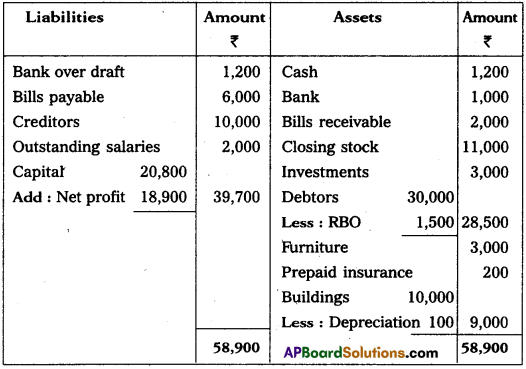
Section – E
Answer any ONE of the following questions.
Question 19.
Prepare Three Column Cash Book from the following Transactions :
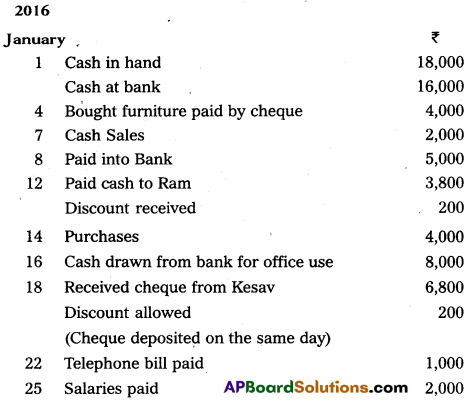
Answer:

Question 20.
Prepare Bank Reconciliation Statement of Vaishanavi Traders as on 31st December, 2015 :
1) Bank balance as per cash book ₹ 21,000
2) Cheques deposited but not collected ₹ 6,000
3) Cheques issued but not presented for payment ₹ 2,000
4) Bank charges debited in Pass book only ₹ 100
5) Cheques directly deposited by a customer but not entered in cash book ₹ 2,000.
Answer:
Bank Reconciliation Statement of Vaishanavi Traders as on 31.12.2015
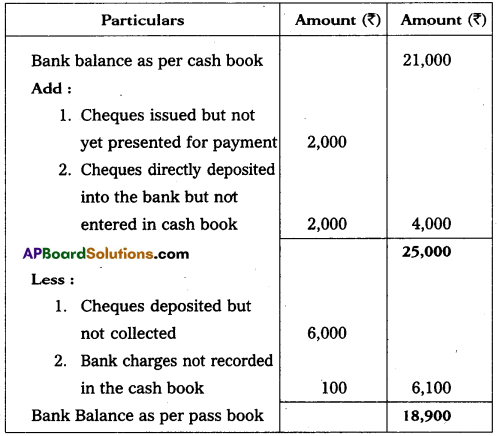
Section – F
(2 × 5 = 10)
Answer any TWO of the following questions.
Question 21.
Explain the rules of debit and credit of different Accounts with suitable examples.
Answer:
The accounts are broadly divided into two types.
1. Personal Accounts
2. Impersonal accounts.
1. Personal Accounts : These accounts relate to the persons or firms. Ex. : Rama’s a/c, Andhra Bank a/c., LIC a/c, Infosys Ltd. The rule in personal accounts is “Debit the receiver and credit the giver”.
2) Impersonal accounts : Impersonal accounts are those accounts which are not personal accounts. They are again divided into
i) Real Accounts
ii) Nominal Accounts.
i) Real Accounts : These accounts are related to the assets and properties. Ex. : Building, machinery, stock, goodwill etc.
The rule in real accounts is “Debit what comes in and credit what goes out”.
ii) Nominal Accounts : These accounts relate to expenses, incomes or gains or losses. Ex.: Salary a/c, Rent a/c, Commission received a/c, interst received a/c etc.
The rule in nominal accounts is “Debit all expenses and losses and credit all incomes and gains”.
![]()
Question 22.
Decribe any five types of Errors.
Answer:
Errors are classified into two types.
1) Error of principle
2) Clerical errors
1) Error of principle: Error of principle occurs where errors are made due to defective knowledge of accounting principles. These may arise, when distinction is not made between capital and revenue nature items.
2) Clerical errors : When mistake is committed while recording them in the books of original entry or posting them in the ledger are called clerical errors. They are again divided into following types of errors.
a) Errors of omission : These errors occur due to omission of some transactions in any subsidiary books.
b) Errors of commission : These errors arises because of mistakes in calculations, totalling, carry forward or balancing.
c) Compensating errors : These errors arise when one error is compensated by other error or errors.
Question 23.
Prepare Charan Account from the following :
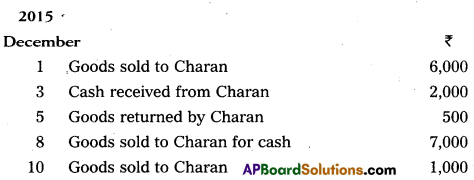
Answer:
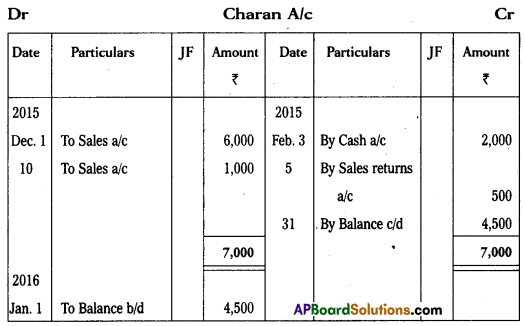
Question 24.
Enter the following in Purchases and Purchase Return Journal:
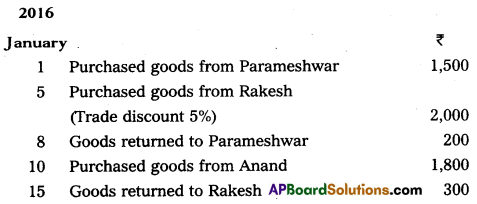
Answer:
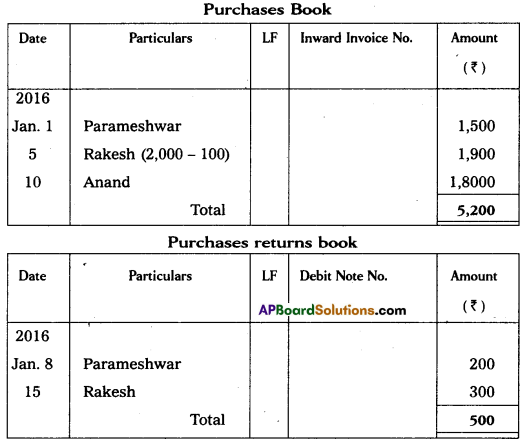
Section – G
(5 × 2 = 10)
Answer any FIVE of the following questions.
Question 25.
Define Accounting.
Answer:
The American Institute of Public Accountants defined accounting as “the art of recording, classifying and summarising in significant manner and in terms of money transactions and events which are in part, atleast of financial character and interpreting the results thereof’.
Question 26.
Business Entity Concept
Answer:
Business is treated as separate from the proprietor. All the transactions are recorded in the books of business but not in the books of proprietor. The proprietor is also treated as creditor of the business when he contributes capital he is treated as a person who has invested amount in business. So capital appears on the liabilities side in the Balance sheet.
Question 27.
Double Entry System
Answer:
According to J.R. Batliboi,”Every business transaction has a two-fold effect and that it affects two accounts in opposite directions and if a complete record were to be made of each such transaction, it would be necessary to debit one account and credit another account. This recording of the two fold effect of every transaction has given rise to the term double entry system of book-keeping is that “for every debit there must be corresponding value of credit”.
![]()
Question 28.
Journalise the following Transactions :

Answer:
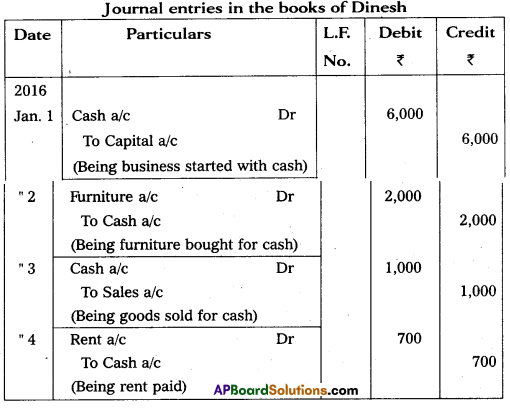
Question 29.
Record the opening entry from the following particulars on 1st January, 2016 :
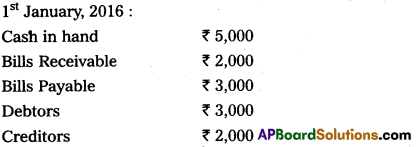
Answer:

Question 30.
Prepare Trial Balance of Krishna as on 31.12.15:

Answer:
Trial Balance of Krishna as on 31.12.2015
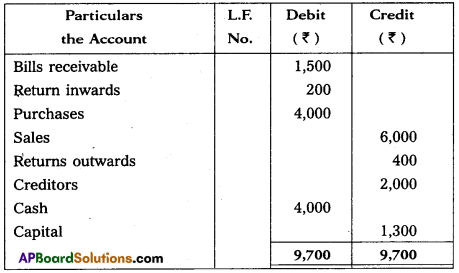
Question 31.
Suspense Account
Answer:
Suspense account is an imaginary account, opened and used as a temporary measure to make the two sides of the trial balance agree. As and when the errors which causes the disagreement in trial balance is detected, rectification entries should be passed through suspense account.
Detection and rectification of all the errors will result in automatic closure of suspense account.
Question 32.
What is Capital Expenditure?
Answer:
Expenses incurred on acquiring assets are capital expenditure. These assets are shown at the assets side of Balance sheet. These expenditure should not be shown at the debit side of profit and loss account. Ex.: Purchase of land and buildings, plant etc.